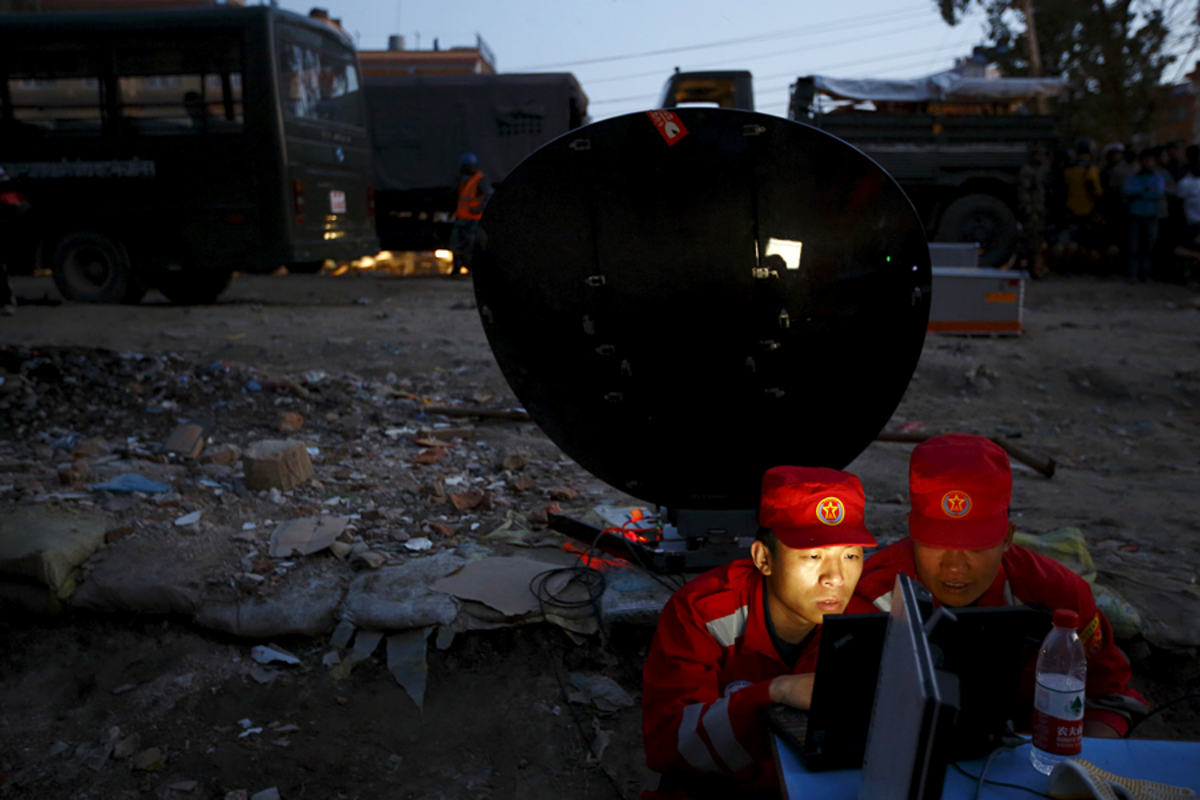How technology is helping us map earthquakes faster than ever
Loading...
In the aftermath of the earthquake in Nepal on Saturday, technology has stepped into the information gap to help map the terrain for first responders using GPS, satellite, and open-source data.
Researchers at the US Geological Survey, the University of Iowa, NASA's Jet Propulsion Laboratory, and other groups expect to have the first post-earthquake images to come from satellites – due to pass over the affected regions on Tuesday morning, Nepal time – which they will use to create three-dimensional images of how the earth moved during the quake.
These images will aid in directing relief efforts effectively and conducting science that may lead to a better understanding of earthquakes and their early warning systems, says a geoscientist at the University of Iowa who formerly worked with the USGS and who is assisting the agency on this work.
On Saturday, a 7.8 magnitude earthquake struck less than 50 miles from Kathmandu, leveling buildings and killing more than 4,000 people, according to reports.
The quake, the country's biggest in eight decades, triggered an avalanche on Mt. Everest, which killed at least 18 climbers. Tremors were felt in India, Tibet, and Bangladesh.
Soon after the quake hit Nepal, those on Twitter and other social media networks began searching for reports from those on the ground in affected areas in order to help gauge the damage and assist relief efforts to the area.
One effort, The “applies the principles of open source and open data sharing for humanitarian response and economic development,” according to its website.
The team asks those living in the affected areas to help out by which buildings are damaged, which are still standing, and where fissures and other quake damage are located.
According to Prof. Barnhart, it’s as important to report a building that’s still standing as it is to report one that’s gone down, so we can assess the infrastructure.
Barnhart explains that the data used to map a quake is collected from several different sources.
readings can, within 30 minutes, report a quake's location, magnitude, impact, and potential monetary damage estimates. A seismograph, which measures the movement of the earth, consists of a ground-motion detection sensor, called a seismometer, paired with a recording system.
Publically accessible platforms involve people in the affected zones reporting damaged and undamaged buildings, fissures and other damage.
Then there is local station data, which, when combined with satellite data, is called .
“We’re still trying to obtain as much of this information as possible,” he says. “The GPS data is run by various universities internationally, some are recording in real time, some are not so right now we’re waiting for that data to come out.”
At the moment, some of that data still has to be “telemetered,” or sent from the GPS server on the ground so that the USGS can access it.
“In a case like this I think many of those networks were telemetered through Kathmandu,” he says. “It’s tough right now, because so much of the infrastructure in the country has been damaged so severely and the data is dependent on the infrastructure to get out.”
USGS is also using remote sensing, a combination of satellite data from optical satellites as well as radar satellites, according to Barnhart.
This is not the kind of GPS data that a source such as Google Earth could provide, he says, “For GPS data to be useful it has to be very close to the earthquake, because it’s sensing the actual physical permanent ground displacement caused by the earthquake.”
“The GPS, it has to be right in the zone of the earthquake itself otherwise it doesn’t record anything,” he says.
Meanwhile, seismometers can be distributed globally because they’re sensing the seismic waves that travel through the entire planet.
The term for using of GPS to accurately measure, map and understand the Earth is called geodesy, and it’s playing a significant role in making sure limited resources go to where they are most urgently needed in Nepal this week.
Barnhart says it is also the next step to take in early warning systems here in the United States that would allow for a quicker shutdown of schools and nuclear facilities in a seismic event, tsunami, or landslide.
“Right now a lot of work is going into actually using these geodetic networks in earthquake early warning,” he says. “Until now earthquake early warning has been traditionally within the realm of seismology only. But there can be a lot of ambiguity when an earthquake starts to happen – from a seismological perspective.”
Barnhart concludes, “The nice thing about geodesy is that if you have several GPS stations along a fault and you can see them unrolling in real time and they move one or two meters, you don’t even need to know the magnitude of the earthquake is. You know a big earthquake just happened. So a lot of work is being done right now by researches to incorporate GPS into early warning systems.”





